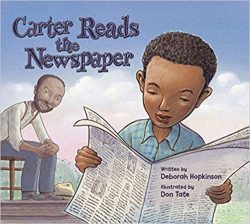
Our collection of picture books featuring Black and Indigenous people and People of Color (BIPOC) is available to the public. *Inclusion of a title in the collection DOES NOT EQUAL a recommendation.* Click here for more on book evaluation.
Find titles using a keyword search below (e.g. adoption, birthday, holidays, etc.), or by selecting one or a combination of filters on the lefthand sidebar below.
First time here? Start here!
5 matching books
Show Filters
Exquisite
"A picture-book biography of celebrated poet Gwendolyn Brooks, the first Black person to win the Pulitzer Prize" -- publisher

Sewing stories
"Harriet Powers learned to sew and quilt as a young slave girl on a Georgia plantation. She lived through the Civil War and Reconstruction, and eventually owned a cotton farm with her family, all the while relying on her skills with the needle to clothe and feed her children. Later she began making pictorial quilts, using each square to illustrate Bible stories and local legends. She exhibited her quilts at local cotton fairs, and though she never traveled outside of Georgia, her quilts are now priceless examples of African American folk art."--Amazon.com

Brave ballerina
Janet Collins wanted to be a ballerina in the 1930s and 40s, a time when racial segregation was widespread in the United States. From her early childhood lessons to the height of her success as the first African-American prima ballerina in the Metropolitan Opera, this is the story of a remarkable pioneer. Full color

Carter reads the newspaper
Carter G. Woodson was born ten years after the end of the Civil War, to parents who had both been enslaved. Their stories were not the ones written about in history books, but Carter learned them and kept them in his heart. Carter's father could not read or write, but he believed in being an informed citizen. So Carter read the newspaper to him every day, and from this practice, he learned about the world and how to find out what he didn't know. Many years later, when he was a student at Harvard University (the second African-American and the only child of enslaved parents to do so), one of his professors said that black people had no history. Carter knew that wasn't true--and he set out to make sure the rest of us knew as well.--Provided by the publisher

A dance like starlight
A young girl growing up in Harlem in the 1950s, whose mother cleans and stitches costumes for a ballet company, dreams of becoming a prima ballerina one day, and is thrilled to see a performance of Janet Collins, the first "colored" prima ballerina
